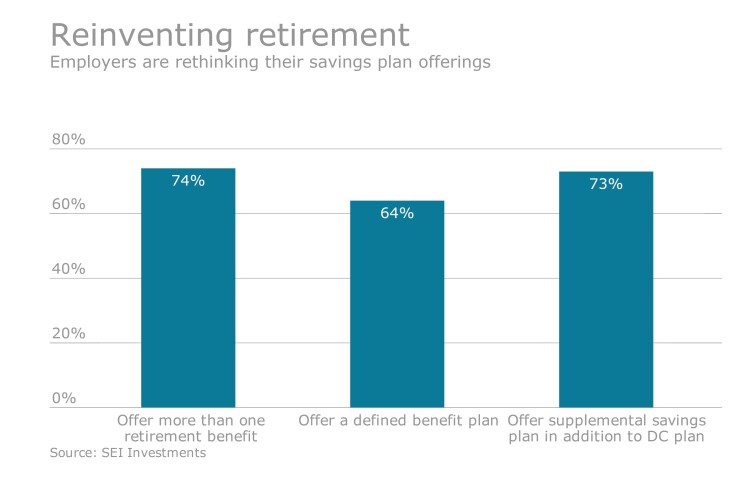When it comes to retirement plans, employers face a big challenge: How to motivate employees to participate.
Various enrollment methods have been developed to encourage participation and consider basic human behavior, but each carries tradeoffs. Standard enrollment and auto-enrollment have been widely adopted, but active-choice enrollment has been an area somewhat unexplored.
A traditional enrollment process allows participants to choose to participate in, or opt-in to, a retirement plan.

This method requires employee initiation. Unfortunately, when this decision is left entirely up to employees, some basic behaviors take over. These include loss aversion, present bias and procrastination.
Loss aversion happens when employees weigh out the costs and benefits of setting aside part of their paycheck every month to save for retirement. The perceived losses receive undue importance when compared with the expected benefits. In simpler terms, giving up income today is a bigger deal than receiving income in the future.
Present bias is this same idea of unequal importance of costs and benefits, but compounded by time. The costs are borne immediately and the benefits are not realized until much further in to the future. The delay in benefit when it comes to retirement savings is decades long. Employees may not be able to extrapolate their decisions this far into the future.
Procrastination will also come into play, causing decisions about saving for retirement to be put off until employees feel they make enough money to save, know enough about how much to save, or have enough time to make these crucial savings decisions.
These psychological forces are hard for all humans to overcome and the default of not enrolling in the retirement savings plan is, to many potential participants, the path of least resistance.
One solution to the motivation conundrum is the auto-enrollment process. This process allows a plan sponsor to automatically enroll eligible employees into the plan unless an employee affirmatively elects otherwise.
When employees do not have to act to be enrolled, participation can increase by up to 50% as compared to traditional enrollment, while giving employees the flexibility to not participate if they decide the retirement plan or automatic savings rate is not right for them.
However, many default savings rates prove to be sticky; participants consider them an implicit recommendation and are reluctant to stray from it. Default savings rates are most commonly set at 2-4%, which is not the optimal long-term savings rate for most participants. Loss aversion and present bias appear when participants weigh the costs and benefits of increasing savings above the default rate. Conversely, these same default savings rates may not be affordable for certain participants.
In addition to the psychological struggles that auto-enrollment presents, certain plan sponsors feel that auto-enrolling participants is too paternalistic. The politics of a plan sponsor taking the choice out of participation can be tricky or impossible to navigate.
A different path
Active-choice enrollment requires employees to actively make the decision to participate, or not, in their retirement plan.
This differs from the other enrollment processes, which allow participants to default into a state of participation. By mandating employees to decide, plan sponsors may better serve employees who might struggle with procrastination, and can offer more tailored engagement than an auto-enroll process may provide.
The retirement, technology, voluntary, wellness and overall winners are taking charge of the future of benefits.
Usually, the active choice is presented to employees along with other new-hire materials that must be completed or returned within a specified period. Employees decide between two options: Enroll or Waive; Yes, I want to participate or No, I do not want to participate, etc. If participants choose to participate, they are prompted to make contribution rate decisions immediately or in the near future.
By making the decision time-bound, employees are more likely to make an instant decision regarding their savings. This can result in a positive or negative effect. On the one hand, it starts employee saving as early as possible, maximizing compounding. Additionally, employees enrolled through active choice have been found to immediately choose a savings rate that took traditional enrolled participants more than two years to reach through contribution increases.
But the immediate decision can place unprepared employees in a situation where they are not informed enough to make the proper savings rate decision for their specific circumstance. Financially illiterate employees may be better served through a carefully chosen default savings rate and auto-enrollment.
Enhanced active voice
Active choice can be elaborated upon to include language that invokes an emotional response from potential participants. Known as enhanced active choice, this process adds descriptive language to the decision. Instead of choice between “Enroll,” or “Waive,” the participant must choose between such statements as “Yes, I want to plan for a successful retirement by saving and investing money today.” and “No, I do not want to save today and understand that this choice may negatively affect my retirement.”
This style of active choice taps into human instinct, highlighting the possible positive and negative effects of this choice in a visceral way. Plan sponsors who adopt enhanced active choice should be sure to not use language that implies any guarantee of success or failure.
The principles behind active-choice enrollment relieve many pain points that exist in other enrollment methods. Active-choice enrollment increases plan participation. By allowing employees to choose, plans will have more engaged, empowered participants. By requiring employees to choose for themselves, and making it easy to enroll, plans can help participants sidestep behavioral roadblocks and end up on track for a more successful retirement.






